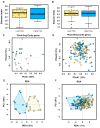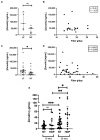Dietary Fiber Intake Alters Gut Microbiota Composition but Does Not Improve Gut Wall Barrier Function in Women with Future Hypertensive Disorders of Pregnancy
- PMID: 33348731
- PMCID: PMC7766248
- DOI: 10.3390/nu12123862
Dietary Fiber Intake Alters Gut Microbiota Composition but Does Not Improve Gut Wall Barrier Function in Women with Future Hypertensive Disorders of Pregnancy
Abstract
Pregnancy alters the inflammatory state, metabolic hormones, and gut microbiota composition. It is unclear if the lower abundance of dietary fiber-fermenting, short-chain fatty acid-producing bacteria observed in hypertension also occurs in hypertensive disorders of pregnancy (HDP). This study investigated the relationship between dietary fiber intake and the gut microbiota profile at 28 weeks gestation in women who developed HDP in late pregnancy (n = 22) or remained normotensive (n = 152) from the Study of PRobiotics IN Gestational diabetes (SPRING). Dietary fiber intake was classified as above or below the median of 18.2 g/day. Gut microbiota composition was examined using 16S rRNA gene amplicon sequencing. The gut permeability marker zonulin was measured in a subset of 46 samples. In women with future HPD, higher dietary fiber intake was specifically associated with increased abundance of Veillonella, lower abundance of Adlercreutzia, Anaerotruncus and Uncl. Mogibacteriaceae and higher zonulin levels than normotensive women. Fiber intake and zonulin levels were negatively correlated in women with normotensive pregnancies but not in pregnancies with future HDP. In women with normotensive pregnancies, dietary fiber intake may improve gut barrier function. In contrast, in women who develop HDP, gut wall barrier function is impaired and not related to dietary fiber intake.
Keywords: dietary fiber; gut microbiota; hypertension; inflammation; pregnancy; zonulin.
Conflict of interest statement
The SPRING study received support from Chr Hansen A/S in the form of donations of the probiotics and placebo capsules.
Figures




Similar articles
-
Gut Microbiota Richness and Composition and Dietary Intake of Overweight Pregnant Women Are Related to Serum Zonulin Concentration, a Marker for Intestinal Permeability.J Nutr. 2016 Sep;146(9):1694-700. doi: 10.3945/jn.116.235358. Epub 2016 Jul 27. J Nutr. 2016. PMID: 27466607
-
Low dietary fiber intake increases Collinsella abundance in the gut microbiota of overweight and obese pregnant women.Gut Microbes. 2018;9(3):189-201. doi: 10.1080/19490976.2017.1406584. Epub 2018 Mar 13. Gut Microbes. 2018. PMID: 29144833 Free PMC article.
-
Maternal Soluble Fiber Diet during Pregnancy Changes the Intestinal Microbiota, Improves Growth Performance, and Reduces Intestinal Permeability in Piglets.Appl Environ Microbiol. 2018 Aug 17;84(17):e01047-18. doi: 10.1128/AEM.01047-18. Print 2018 Sep 1. Appl Environ Microbiol. 2018. PMID: 29959248 Free PMC article.
-
Broadening horizons: intestinal microbiota as a novel biomarker and potential treatment for hypertensive disorders of pregnancy.Front Cell Infect Microbiol. 2024 Aug 22;14:1446580. doi: 10.3389/fcimb.2024.1446580. eCollection 2024. Front Cell Infect Microbiol. 2024. PMID: 39239636 Free PMC article. Review.
-
Effect of dietary fiber on gut barrier function, gut microbiota, short-chain fatty acids, inflammation, and clinical outcomes in critically ill patients: A systematic review and meta-analysis.JPEN J Parenter Enteral Nutr. 2022 Jul;46(5):997-1010. doi: 10.1002/jpen.2319. Epub 2022 Jan 27. JPEN J Parenter Enteral Nutr. 2022. PMID: 34951702
Cited by
-
Dietary Nutrition and Gut Microbiota Composition in Patients With Hypertensive Disorders of Pregnancy.Front Nutr. 2022 Apr 6;9:862892. doi: 10.3389/fnut.2022.862892. eCollection 2022. Front Nutr. 2022. PMID: 35464021 Free PMC article.
-
Effect of Saengshik Supplementation on the Gut Microbial Composition of Healthy Korean Adults: A Single-Group Pilot Study.Front Nutr. 2021 Oct 22;8:743620. doi: 10.3389/fnut.2021.743620. eCollection 2021. Front Nutr. 2021. PMID: 34746209 Free PMC article.
-
Associations between the Gut Microbiota, Urinary Metabolites, and Diet in Women during the Third Trimester of Pregnancy.Curr Dev Nutr. 2022 Dec 24;7(4):100025. doi: 10.1016/j.cdnut.2022.100025. eCollection 2023 Apr. Curr Dev Nutr. 2022. PMID: 37304851 Free PMC article.
-
Breaking the Barrier: The Role of Gut Epithelial Permeability in the Pathogenesis of Hypertension.Curr Hypertens Rep. 2024 Sep;26(9):369-380. doi: 10.1007/s11906-024-01307-2. Epub 2024 Apr 25. Curr Hypertens Rep. 2024. PMID: 38662328 Free PMC article. Review.
-
Gestational Diabetes and the Gut Microbiota: Fibre and Polyphenol Supplementation as a Therapeutic Strategy.Microorganisms. 2024 Mar 22;12(4):633. doi: 10.3390/microorganisms12040633. Microorganisms. 2024. PMID: 38674578 Free PMC article. Review.
References
MeSH terms
Substances
Grants and funding
LinkOut - more resources
Full Text Sources
Medical

